Catalan is the first new full addition to Transifex - our new localization/translation home. We've blogged previously about our efforts to localize Ushahidi. Finally, we are pleased to launch Transifex as the platform to equip translators and developers with their Ushahidi language/localization needs. (Ushahidi previously used Tafsiri (in-house tool) and Github Translations.)
We were happily surprised at the speed of the Catalan (Spain) localization. This was done over the past few days by a diligent community member. As you can see from the site, each language varies in "completeness". Our 2012 goal is to have 25 localizations fully complete. Ushahidi deployments with completed languages make it easier for the local regions to communicate with their users. With your help, we'd like to better serve them.
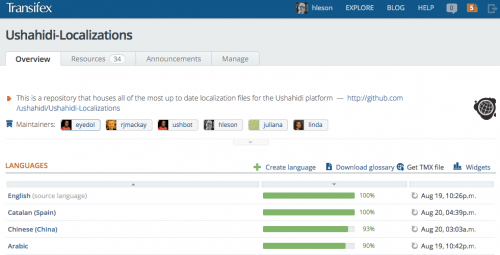 Translation status by product:
Translation status by product:
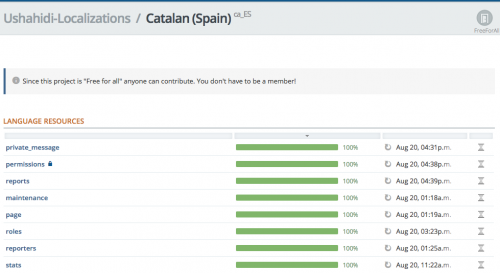 You will be provided options in a pop-up window. The "source string" is the English word or phrase to be translated. You can either download the items and translate it. Or, you can click "translate now" to proceed with online translation.
You will be provided options in a pop-up window. The "source string" is the English word or phrase to be translated. You can either download the items and translate it. Or, you can click "translate now" to proceed with online translation.
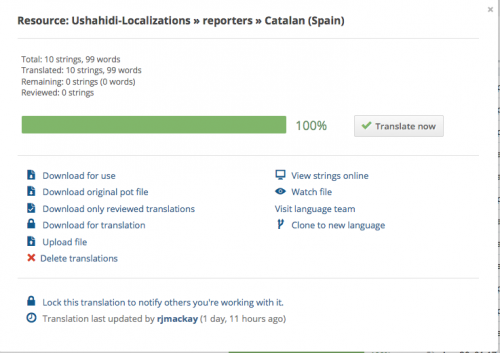 On the right hand side, you can see the translation space for items to be added. Once you are done translating the "source string", click "Save all" in the bottom right-hand corner of the screen.
On the right hand side, you can see the translation space for items to be added. Once you are done translating the "source string", click "Save all" in the bottom right-hand corner of the screen.
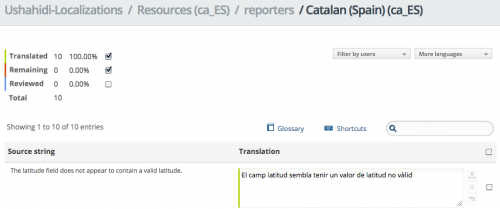 To learn more about how to get started in with localization and translation, see these two wiki articles:
Localization and translation - How to (includes links to Transifex's documentation)
Localization and translation - FAQ
To learn more about how to get started in with localization and translation, see these two wiki articles:
Localization and translation - How to (includes links to Transifex's documentation)
Localization and translation - FAQ
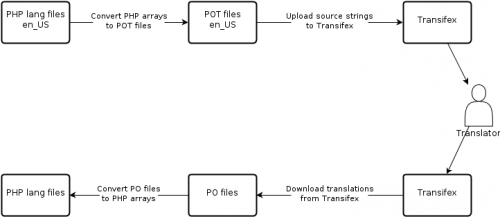 To get a deeper understanding of the technical set-up, there are two additional wiki articles:
Localization - Under the Hood and Localization - Developer Best practices.
Also for those who deploy from git, note that localizations are now included in core as a submodule.
To get a deeper understanding of the technical set-up, there are two additional wiki articles:
Localization - Under the Hood and Localization - Developer Best practices.
Also for those who deploy from git, note that localizations are now included in core as a submodule.
 Translation status by product:
Translation status by product:
- Ushahidi-Localizations (this is the Ushahidi platform) (on Transifex)
- Ushahidi Android (on Transifex)
- SMSSync (on Transifex)
- Crowdmap (uses translations from Ushahidi platform)
- Ushahidi ios - the next release will use Transifex for translations
- SwiftRiver (product is in beta, waiting until stable version)
How it works
Translations in the form of "strings" or "word(s)" are synced, converted back to Ushahidi's native format (PHP arrays) and updated on on Github. This happens every 12 hours. If you are an Ushahidi platform deployer, you can pull these translations directly from Github to add into your installation. In future platform releases we'll make things simpler by shipping all translations with the platform. If you are a Crowdmap user, languages will be updated with each code release. Transifex provides a more user-friendly environment for translators while easily connecting to our fast paced software development. Each Ushahidi platform word and associated strings are listed as "resources" in Transifex. The "resources" are associated with a localization to be translated. Each language has "language resources" which are separated into strings and words to be translated.To translate
It is easy to get started on translations. You can add a few words or full strings or sets of "language resources". The first steps are to join the Transifex Community, then search for the "Ushahidi-localization" project (or a different product) to join. When you click on a language, you will see available "language resources" to be translated. Click on the "language resource" to proceed. You will be provided options in a pop-up window. The "source string" is the English word or phrase to be translated. You can either download the items and translate it. Or, you can click "translate now" to proceed with online translation.
You will be provided options in a pop-up window. The "source string" is the English word or phrase to be translated. You can either download the items and translate it. Or, you can click "translate now" to proceed with online translation.
 On the right hand side, you can see the translation space for items to be added. Once you are done translating the "source string", click "Save all" in the bottom right-hand corner of the screen.
On the right hand side, you can see the translation space for items to be added. Once you are done translating the "source string", click "Save all" in the bottom right-hand corner of the screen.
 To learn more about how to get started in with localization and translation, see these two wiki articles:
Localization and translation - How to (includes links to Transifex's documentation)
Localization and translation - FAQ
To learn more about how to get started in with localization and translation, see these two wiki articles:
Localization and translation - How to (includes links to Transifex's documentation)
Localization and translation - FAQ
If you are a developer....
For developers, we recommend that you and your translators use Transifex as the "source of truth" for localization and translation needs. Here is a diagram on how it works: To get a deeper understanding of the technical set-up, there are two additional wiki articles:
Localization - Under the Hood and Localization - Developer Best practices.
Also for those who deploy from git, note that localizations are now included in core as a submodule.
To get a deeper understanding of the technical set-up, there are two additional wiki articles:
Localization - Under the Hood and Localization - Developer Best practices.
Also for those who deploy from git, note that localizations are now included in core as a submodule.